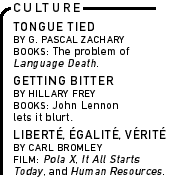
|

|

|

|
| |
|
|
|
Language Death Brief books that suggest the vastness of a topic while delivering a sense of completion are rightly a model for popular writing and scholarship alike. In English as a Global Language (1997) David Crystal, a British authority on language, gave a thorough and at times brilliant account of the rise of English and its future as an essential "second language," whose variety is so great that it is reasonable to ask, as he did, whether English will "fragment." English as a Global Language is the standard work--at a mere 142 pages--on the role of English in the world, and his judgements are holding up remarkably well. Perhaps emboldened by his success, Crystal has tried to do the same--deliver a brief, authoritative essay, without obtrusive scholarly trappings--on the subject of the impending disappearance of thousands of the world's languages. The facts and forecasts are stark: 96 percent of the world's estimated 6,000 languages are spoken by only 4 percent of the people. One-quarter of the world's languages are spoken by less than 1,000 people each and a staggering 5,000 languages have fewer than 100,000 speakers each. By his reckoning, half of the world's languages could disappear this century, and only 600 tongues are "safe" from the threat of extinction. Why does this matter? This question is more complicated than it seems. From one perspective, too many languages divide and isolate people; they impose added burdens on communication, even misunderstandings that fuel conflict. The Biblical "Tower of Babel" fable suggests the way in which language divisions have long been viewed as bedeviling humanity. |

